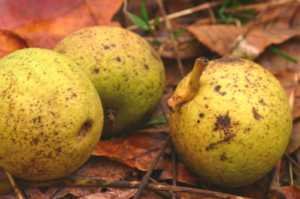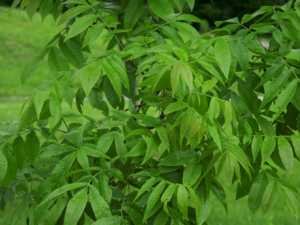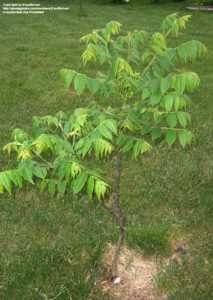





Black Walnuts produce a substance known as juglone which is toxic to many plants, and can cause allergic reactions in humans and horses. Juglone is excreted primarily in the roots, saturating the soil in a radius of 50-60 feet or more in a mature tree. The buds and nut hulls are also high in juglone.
The relationship between plants in which one produces a substance which affects the growth of another is known as "allelopathy", a condition Pliny noted in black walnuts around 77 A.D. (Additional common landscape trees with allelopathic properties are sugar maple, tree-of-heaven, hackberries, southern waxmyrtle, American sycamore, cottonwood, black cherry, red oak, black locust, sassafrass, and American elm.) Juglone is alleopathic to many plants, while other plants are very tolerant of it. (See lists of juglone-sensitive and juglone-tolerant plants below.)
Juglone occurs in the leaves, bark and wood of black walnuts although to a lesser degree than their roots and hulls. A Black Walnut sapling can spread juglone twice the radius of its small canopy. English Walnut and Carpathian Walnut trees are sometimes grafted onto Black Walnut rootstock (Juglans nigra L.) and Butternut rootstock (Juglans cinerea L.), making those trees produce toxins as well. Because juglone is poorly soluble in water, it tends not to leach out of the soil. Many plants such as tomato, potato, blackberry, blueberry, azalea, mountain laurel, rhododendron, red pine and apple may be injured or killed within one to two months of growth within the root zone of these trees. A few other trees closely related to black walnut produce limited quantities of juglone although toxicity is seldom observed. Those trees are butternut, English walnut, pecan, shagbark and bitternut hickory.

 Black Walnuts in Husks
Black Walnuts in HusksThe presence of juglone is highly concentrated immediately under the leaf canopy of black walnuts, both from the tree roots and the accumulation of dead and dying debris. Decaying roots from a dead black walnut tree can still contain juglone for many years. The leaves containing juglone may be composted where the juglone will break down in several weeks from the presence of bacteria, air and water. If you want to test the toxicity of composted walnut leaves, plant tomato seedlings in it. Tomatoes are highly sensitive to juglone and will quickly die in its presence. 
Fresh sawdust and ground black walnut mulch should not be used around plants sensitive to juglone. Black walnut pollen (usually in May) has caused allergic reactions in humans and horses and black walnut bedding in horse stalls has a similar effect. However, mulch made from walnut bark is said to be safe to use on even juglone-sensitive plants after composting 6 months to a year. Frankly, I’d rather not take the chance. And of course, breakdown is directly affected by soil type, micro-organisms and drainage. Spring is a good time to check your vegetable and flower beds for new seedlings emerging from the nut hoard squirrels may have planted the previous fall. Pulling them out now before their roots take hold is quite easy.
There are some benefits to growing black walnuts. One is the delicious nutmeat, and another is the dye you can make from the hulls. Black walnuts have been recommended for pastures on hillsides in the Ohio Valley and Appalachian mountains to hold the soil and prevent erosion. They provide shade for cattle. There is also said to be a beneficial effect on growing Kentucky bluegrass in pastures.
Medicinal Properties of Black Walnuts
Black Walnut has antifungal; anti-parasitic and antiseptic properties. Rubbed on the skin, Black Walnut extract is reputed to be beneficial for eczema, herpes, psoriasis, and skin parasites. External applications have been known to kill ringworm. The Chinese are said to use Black Walnut to kill tapeworms with extremely good success.
The brown stain found in the green husk of black walnuts contains organic iodine, which has antiseptic and healing properties and also makes a good insect repellant.
There are several things a gardener may consider if you have black walnuts on your property. You should locate your garden area as far from the walnuts as possible. If that is not possible, consider raised beds but build them in such a way as to prevent black walnut roots from getting in to the planting area. Keep the area clean of all leaves and other debris from the black walnut trees.
Culinary Properties of Black Walnuts
Black walnuts have a strong, rich, smoky flavor with a hint of wine. Use them any recipe that call for nuts. Caution: the black walnut flavor may overpower everything else. Combine them 1:3 with English walnuts to tone down the flavor.
Black Walnut Chicken Quiche
1 cup finely chopped cooked chicken
1 cup grated Swiss cheese
1/4 cup chopped onion
1 tablespoon flour
2 eggs, beaten
1/2 teaspoon spicy brown mustard
1 cup milk
1 cup Black Walnuts, chopped
1 baked 9-inch pie crust
Mix chicken, cheese, onion, flour and 1/2 cup Black Walnuts. Sprinkle into crust. Mix beaten eggs, milk and mustard. Pour over chicken mixture; top with remaining Black Walnuts. Bake at 325 degrees for 50 minutes. 6 servings.
Photo Credits: Thanks to hczone6 and Equilibrium for use of their photos from Plantfiles.
Black Walnut tree, iStockPhoto.com, # 3714758, Used by Permission
Black Walnuts, ©Dominika Sebjan, iStockPhoto.com #2336710, Used by Permission
Plants Observed Growing Under or Near Black Walnuts*
Trees
* Japanese Maples, Acer palmatum and its cultivars
* Southern Catalpa, Catalpa bignonioides
* Eastern Redbud, Cercis canadensis
* Canadian Hemlock, Tsuga canadensis
Vines and Shrubs
* Clematis 'Red Cardinal'
* February Daphne, Daphne mezereum
* Euonymus species
* Weeping Forsythia, Forsythia suspensa
* Rose of Sharon, Hibiscus syriacus
* Tartarian Honeysuckle, Lonicera tatarica, and most other Lonicera species
* Virginia Creeper, Parthenocissus quinquefolia
* ** Pinxterbloom, Rhododendron periclymenoides
* **'Gibraltar' and 'Balzac', Rhododendron Exbury hybrids
* Multiflora Rose, Rosa multiflora
* Black Raspberry, Rubus occidentalis
* Arborvitaes, Thuja species
* ** Koreanspice Viburnum, Viburnum carlesii, and most other Viburnum species
Annuals
* Pot-marigold, Calendula officinalis 'Nonstop'
* Begonia, fibrous cultivars
* Morning Glory, Ipomoea 'Heavenly Blue'
* Pansy Viola
* Zinnia species
Vegetables
* Squashes, Melons, Beans, Carrots, Corn
Fruit Trees
* Peach, Nectarine, Cherry, Plum
* Prunus species, Pear-Pyrus species
Herbaceous Perennials
* Bugleweed, Ajuga reptans
* Hollyhock, Alcea rosea
* American Wood Anemone, Anemone quinquefolia
* Jack-in-the-Pulpit, Arisaema triphyllum
* European Wild Ginger, Asarum europaeum
* Astilbe species
* Bellflower, Campanula latifolia
* **Chrysanthemum species (some)
* Glory-of-the-Snow, Chionodoxa luciliae
* Spring Beauty, Claytonia virginica
* Crocus species
* Dutchman's Breeches, Dicentra cucullaria
* Leopard's-Bane, Doronicum species
* Crested Wood Fern, Dryopteris cristata
* Spanish Bluebell, Endymion hispanicus
* Winter Aconite, Eranthis hyemalis
* Snowdrop, Galanthus nivalis
* Sweet Woodruff, Galium odoratum
* Herb Robert, Geranium robertianum
* Cranesbill, Geranium sanguineum
* Grasses (most) Gramineae family
* Jerusalem Artichoke, Helianthus tuberosus
* Common Daylily, Hemerocallis 'Pluie de Feu'
* Coral Bells, Heuchera x brizoides
* Orange Hawkweed, Hieracium aurantiacum
* Plantain-lily, Hosta fortunei 'Glauca'
* Hosta lancifolia
* Hosta marginata
* Hosta undulata 'Variegata'
* Common Hyacinth, Hyacinthus Orientalis 'City of Haarlem'
* Virginia Waterleaf, Hydrophyllum virginianum
* Siberian Iris, Iris sibirica
* Balm, Monarda didyma
* Wild Bergamot, M. fistulosa
* Grape Hyacinth, Muscari botryoides
* Sweet Cicely, Myrrhis odorata 'Yellow Cheerfulness,' 'Geranium,' 'Tete a Tete,' 'Sundial,' and 'February Gold'
* Sundrops, Oenothera fruticosa
* Senstitive Fern, Onoclea sensibilis
* Cinnamon Fern, Osmunda cinnamomea
* Peony, **Paeonia species (some)
* Summer Phlox, Phlox paniculata
* Mayapple, Podophyllum peltatum
* Jacob's-Ladder, Polemonium reptans
* Great Solomon's-Seal, Polygonatum commutatum
* Polyanthus Primrose, Primula x polyantha
* Lungwort, Pulmonaria species
* Bloodroot, Sanguinaria canadensis
* Siberian Squill, Scilla sibirica
* Goldmoss Stonecrop, Sedum acre
* Showy Sedum, Sedum spectabile
* Lamb's-Ear, Stachys byzantina
* Spiderwort, Tradescantia virginiana
* Nodding Trillium, Trillium cernuum
* White Wake-Robin, Trillium grandiflorum
* Tulipa Darwin 'White Valcano' and 'Cum Laude,' Parrot 'Blue Parrot,' Greigii 'Toronto'
* Big Merrybells, Uvularia grandiflora
* Canada Violet, Viola canadensis
* Horned Violet, Viola cornuta
* Woolly Blue Violet, Viola sororia
*These are based upon observations and not from clinical tests.
**Cultivars of some species may do poorly.
Plants That DO NOT Grow Within 50 Feet of the Drip Line of Black Walnut
Herbaceous Perennials
* Colorado Columbine, Aquilegia caerulea
* Wild Columbine, Aquilegia canadensis
* Asparagus, Asparagus offinalis
* *Chrysanthemum Chrysanthumum species (some)
* Baptisia australis
* Hydrangea species
* Lilies, Lilium species (particularly the Asian hybrids)
* Alfalfa, Medicago sativa
* Buttercup, Narcissus 'John Evelyn,' 'Unsurpassable' 'King Alfred' and 'Ice Follies'
* Peonies, *Paeonia species (some)
* Rhubarb, Rheum rhabarbarum
Trees
* Silver Maple, Acer saccharinum
* European Alder, Alnus glutinosa
* White Birches, Betula species
* Northern Hackberry, Celtis occidentalis
* Apples and Crabapples, Malus species
* Norway Spruce, Picea abies
* Mugo Pine, Pinus mugo
* Red Pine, Pinus resinosa
* Eastern White Pine, Pinus strobus
* Basswood, Tilia heterophylla
Shrubs
* Red Chokeberry, Aronia arbutifolia
* Hydrangea species
* Mountain Laurels, Kalmia species
* Privet, Ligustrum species
* Amur Honeysuckle, Lonicera maackii
* Brush Cinquefoil, Potentilla species
* Rhododendrons and Azaleas, **Rhododendron species (most)
* Blackberry, Rubus allegheniensis
* Lilacs, Syringa species and cultivars
* Yew, Taxus species
* Blueberry, Vaccinium corymbosum
* *Viburnum plicatum tomentosum 'Mariesii'
Annuals and Vegetables Transplants
* Cabbage, Brassica oleracea capitata
* Peppers, Capsicum species (some)
* Tomatoes, Lycopersicon esculentum
* Flowering Tobacco, Nicotiana alata
* Petunia species and cultivars
* Eggplant, Solanum melongena
* Potato, Solanum tuberosum
* double-flowered cole vegetables
*Cultivars of some species may survive but will do poorly.
Thanks to Ohio State University for their lists of juglone-tolerant and juglone-sensitive plants.
Other sites with lists of plants resistant and susceptible to juglone
http://web1.msue.msu.edu/msue/iac/greentip/blackwal.htm
http://www.ext.vt.edu/pubs/nursery/430-021/430-021.html
Copyright © www.100flowers.win Botanic Garden All Rights Reserved